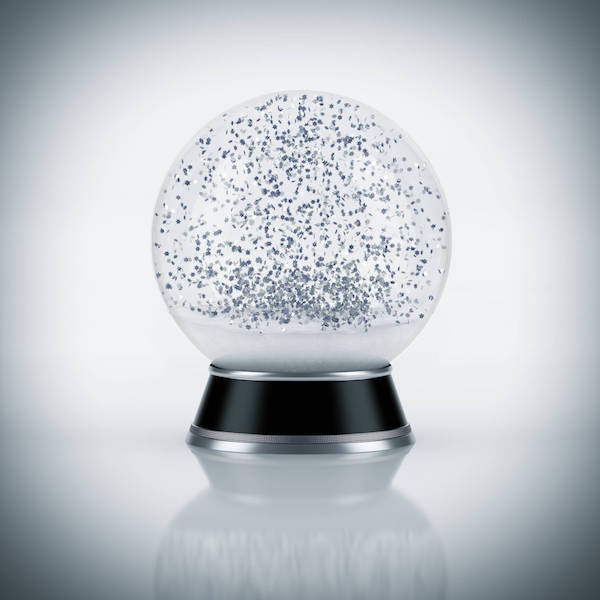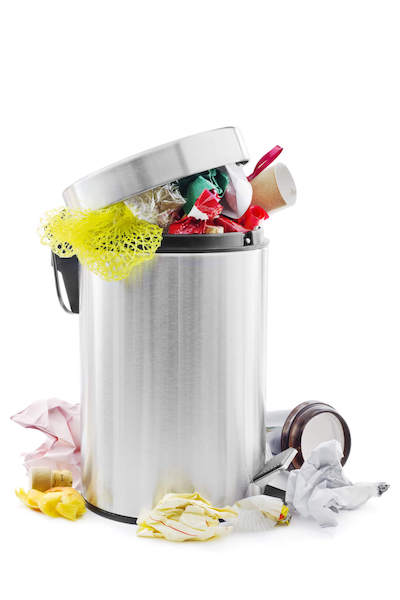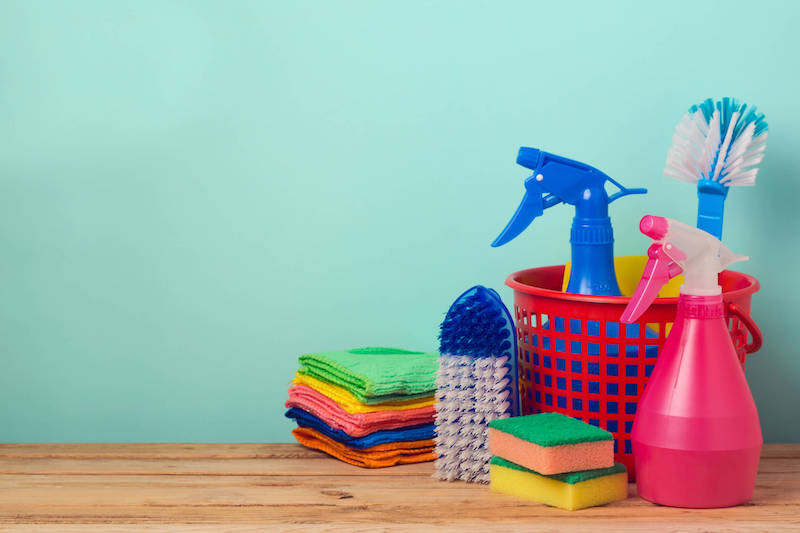Garbage can maintenance probably isn’t a top concern for most of us when it comes to tackling kitchen chores. It’s more of an out-of-sight, out-of-mind relationship built around convenience. They’re there to hold all of the items we no longer want in our home, and every once in a while, we’ve got to take those trash bags to the bigger bin outside. It's simple, easy, and straightforward. Without proper care, though, these holders of all things garbage might be harboring a deep, dark secret that's a threat to your health. We’re talking about mold in trash cans.

For most, it’s probably an issue that was never considered. The typical fear we have for our garbage cans is that the trash bag broke and now there’s an odor that just won't go away, accompanied by an unidentifiable sludge at the bottom of the bin. Top 10 things that make you go "eeeeewh," right?
All of the food particles and moisture in that muck offer the perfect conditions for a lucky little mold spore, though. Before you know it, it’s not just rotten food you’re smelling. You’ll also get a hint of Eau-de-Mold, musty with a hint of dirty socks. Who doesn’t love that smell permeating into their kitchen?!
Garbage can maintenance may not typically be at the top of our to-do list, but to prevent mold in trash cans and a fungus-filled kitchen, it should absolutely be added to the mix. Here’s how to do it.
That Darn Persistent Mold!
To prevent mold in trash cans, it’s best to understand why it happened in the first place. Knowledge is power and whatnot.
There are over 100,000 species of mold identified so far, and they all reproduce by creating microscopic spores that are released into the air. ¹’² These tiny seed-like spores then travel wherever that breeze takes them. Their dream is to land in a nice, habitable little location that they can colonize and call home. All of which isn't a problem when that cozy place is outdoors (mold is incredibly important for natural processes like decomposition).
This growth doesn’t always occur outdoors, though. It just so happens that our homes often offer the perfect little environments for mold spores to transition into the world of the living. If the conditions are right, that is. When a spore flies in, finds this habitable space, and puts down roots, it will immediately begin to produce more and more spores. Some species can also produce microscopic toxins called mycotoxins that they release when they feel threatened. ³
The problem is that, unlike an outdoor space where there’s plenty of room for all of these particles to disperse and not cause problems, our homes essentially trap these spores and toxins within the confines of those walls.
Picture a snow globe and you’ve got a pretty good idea of what this looks like.
For this indoor growth to occur, a mold spore only needs four ingredients for success: ⁴
- Oxygen (this barely counts, which is why mold can grow in walls)
- Temperature (most species prefer temperatures ranging from 40 to 90 degrees Fahrenheit, but some can survive in extremes)
- Food (mold is like a raccoon, it eats anything)
- Moisture (typically, the missing piece of the moldy puzzle)

The Trash Can, Though?
Now, give your trash can a good hard look. Chances are, that bin is harboring every single component a mold spore needs to start growing. Oxygen? Check. Temperature? It’s in a temperature-controlled room. Food? Unidentifiable particles abound. Moisture? This portion is the unknown variable.
If a trash bag leaks and covers the bottom of the bin in liquid, boom, there’s an opportunity for mold in trash cans to occur. It’s that easy. The trash bag even hides the spill and traps the moisture for that lucky spore. How kind! Chances are, this growth can go on for some time before it’s discovered (because who closely inspects the bottom of the can?!) and that can cause serious problems for those exposed.
It Doesn’t Just Smell Bad, It’s Hurtful
When we encounter a few spores and toxins throughout the day, it doesn’t usually cause an issue. Our immune system will descend, surround the invader, and get rid of it ASAP. Mold in trash cans, though, means that all of those particles are swirling around your kitchen and making their way to other portions of the home.
Another real issue with indoor mold growth is that it skyrockets the chances that a spore will stumble onto another habitable location, creating a second, third, and fourth mold factory.
Now, your immune system isn’t battling a few particles every day; it’s fighting a war on all sides. Every time you take a breath when you’re inside your home, it’s filled with spores, mold particles, and potentially toxins. When it comes to mold in trash cans, bacteria is a real threat too and could be adding to the exposure catastrophe.
All of these foreign particles can cause the immune system to lag, malfunction, or just get overrun as it tries to kick them out of your body. Researchers are still hard at work attempting to figure out exactly how mold exposure affects our bodies, but several factors play a role, making it difficult to accurately pin down. Genetics, pre-existing conditions, species of mold, length of time exposed, presence of mycotoxins, and volume of mold in the indoor air all play roles. ⁵’⁶’⁷’⁸

Some of the most common symptoms of mold exposure include:
- Runny nose
- Cough
- Watery eyes
- Shortness of breath
- Respiratory issues
- Chronic fatigue
- Brain fog
- Neurological problems
- Rashes
- Digestive issues
- Hair loss
The truth is that no two people respond to mold exposure the same way. Some may experience 30 symptoms, and some may have the occasional runny nose. None of these symptoms will be alleviated if the root cause remains in the home, though.
That’s why preventing things like mold in trash cans is so important.
Mold In Trash Cans? I Think Not!
Let’s preface this by saying that preventing mold in trash cans probably won’t be your favorite task. No one wants to spend time with the kitchen accessory that contains all of the garbage. Don’t just push this chore off, though! The kitchen is the perfect location for mold spores to stumble on a million and one habitable locations like the dishwasher, coffee maker, and blender. Removing as many habitable locations as possible helps prevent your kitchen from turning into a mold sanctuary and will keep you and your family safe and healthy.
So bring on trash can maintenance!
First things first, add deep cleaning the trash can to your monthly cleaning list.
This cleaning procedure should include these steps:
- Throw on some protective gloves (a mask isn’t a bad idea either!).
- Remove the garbage bag and any lingering items at the bottom of the bin.
- Take the can either outside or into the bathtub and rinse out... whatever’s in the bottom of the can. You can use the hose outside or the showerhead/bucket inside.
- Use a towel or paper towels to dry out the interior.
- Liberally spray the inside and outside of the bin with an EPA-approved cleaning product like Benefect.
- Allow this to sit for at least 30 seconds.
- Scrub the entire trash can with a cleaning brush (an unused toilet bowl brush is an option).
- Wipe every surface with a microfiber towel (they’re 100 times better at removing particles like mold spores from surfaces).
- Allow the can to dry completely before bringing it back into the kitchen.
This deep cleaning should be tackled at least once a month, but the more often the better! This will get rid of any mold spores in the can, any particles the spores can eat, and any lingering moisture.
Preventing mold in trash cans doesn’t stop there, though. There are other steps you can take as well to help ensure your garbage bin stays clean and free from mold growth.
These mold-prevention tips include:
- Use trash bags with heavy-duty protection against leaks. There will be no moisture or food sources for a lucky spore that landed inside your trash can if there is no leaking liquid or particles.
- Give the inside of the can a quick wipe down every time you take out the garbage. It’s a pain, I know, but it will get rid of any moisture and yummy (for mold) particles that could have snuck into the bin.
- Clean up any spills or splatters ASAP. Mold grows in as little as 24 hours, so it’s crucial to remove those necessary life ingredients to prevent it from growing inside of the garbage can.
- Consider putting any liquids or wet garbage into an airtight bag or container before throwing it into the trash. This is an added layer of protection against spills.
- Do NOT overstuff the trash can. It’s tempting to crush everything down so that there’s more space and so that you don’t have to take the trash out, but this could lead to the bag ripping. A broken bag leads to liveable sludge for mold in the can.

- Don’t go for the three-pointer and throw items into the trash can. Instead, gently place them inside to avoid splatter and spillage.
- Empty the trash can often so you don’t miss any unfortunate spills or hidden mold growth.
- Maintain an indoor humidity level of 30 to 50%. ⁹ High humidity offers enough moisture for mold spores to begin growing and can cause condensation, another wet opportunity.
- Create air circulation in that kitchen. Turn on the exhaust fans while cooking to avoid an abundance of moisture in the air. When that air gets inside of the trash can, it can help support mold growth.
This isn’t an exhaustive list, but it’s a great place to get started to avoid mold growth.
Bye, Bye Mold In Trash Cans
Spores are persistent. Accidents and forgetfulness happen; it’s just a fact of life. Mold doesn’t take a day off, though, so if there’s a random opportunity for growth, it will take it! A secret spill can occur, remain wet for 24 hours, and poof, mold in trash cans materialize.
If you discover mold inside of your garbage bin, the absolute best thing to do is throw the can out and get a brand new one. That way, you can be 100% certain that the contamination is gone and the exposure has stopped.

If you can’t get rid of the trash can immediately, your next best option is to give it a serious mold removal cleaning.
This will involve the deep cleaning process above, except you absolutely need to wear a mask and complete the spray and wipe down steps at least three times. Mycotoxins and bacteria are exceptionally difficult to remove, which means complete decontamination requires extra work and persistence. Make sure you get in every single crack and crevice and throw out all of the microfiber towels when you’re finished. Also, make sure to clean and sanitize the rest of your kitchen to remove any spores and toxins that may be present from the colony in the trash can.
After you’ve given the can the ultimate cleaning and remediation, keep a close eye on it over the next few weeks by pulling out your trusty flashlight and assessing every inch of the can. Mold in trash cans can be difficult to completely get rid of, so if the mold comes back quickly, active growth is more than likely still occurring. You can try to complete the removal process once more, but it’s best to throw the can out, deep clean the kitchen again, and start fresh.
A Healthy, Happy Kitchen

Mold loves our kitchens and it always will. These rooms are filled with all kinds of growth opportunities, food particles, and moisture. It’s why we’ve got to pay extra attention to help prevent things like mold in trash cans because it can occur in the blink of an eye.
By removing the conditions for mold growth, we can keep our kitchens, the "hearts of the home," safe and healthy for ourselves and our families. Even if that means tackling the dreaded trash can deep-cleaning. On the bright side, the more often we clean those trash cans, the less gross and smelly they will be. It’s a win-win. Not to mention, no indoor mold growth means we can focus on what’s really important: making memories and spending time with our families.
Citations:
- Environmental Protection Agency. (n.d.). Mold. EPA. Retrieved from https://www.epa.gov/mold.
- Centers for Disease Control and Prevention. Basic facts about mold and dampness. Centers for Disease Control and Prevention. Retrieved from https://www.cdc.gov/mold/faqs.htm.
- World Health Organization. (n.d.). Mycotoxins. World Health Organization. Retrieved from https://www.who.int/news-room/fact-sheets/detail/mycotoxins.
- Lstiburek, J., Brennan, T., & Yost, N. (2002, January 15). Rr-0208: What you need to know about mold. Building Science Corporation. Retrieved from https://www.buildingscience.com/documents/reports/rr-0208-what-you-need-to-know-about-mold/view.
- Environmental and Occupational Health Assessment Program, & Environmental and Occupational Health Assessment Program, & Health Science Section, Mold Basics for Primary Care Clinicians (2009). Hartford, CT; Connecticut Department of Public Health. , H. S. S., Mold Basics for Primary Care Clinicians 1–10 (2009). Hartford, CT; Connecticut Department of Public Health.
- Curtis, L., Lieberman, A., Stark, M., Rea, W., & Vetter, M. (2004). Adverse health effects of indoor molds. Journal of Nutritional & Environmental Medicine, 14(3), 261-274.
- Bush, R. K., Portnoy, J. M., Saxon, A., Terr, A. I., & Wood, R. A. (2006). The medical effects of mold exposure. Journal of Allergy and Clinical Immunology, 117(2), 326-333
- Fisk, W. J., Lei-Gomez, Q., & Mendell, M. J. (2007). Meta-analyses of the associations of respiratory health effects with dampness and mold in homes. Indoor air, 17(4), 284-296.
- EPA. (n.d.). A Brief Guide to Mold, Moisture, and Your Home. EPA. Retrieved from https://www.epa.gov/mold/brief-guide-mold-moisture-and-your-home#tab-6.

